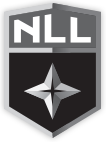(Rochester, NY)… The Rochester Knighthawks and the Seneca Nation partnered with the RIT Native American Student Association (NASA) on Wednesday to offer a lacrosse cultural panel and clinic, as part of NASA’s Native American Heritage Month programming.
Knighthawks players Zed Williams and Jake Piseno, both members of the Haudenosaunee national team, and Taylor Jensen, a former RIT Tiger, spoke with RIT students, youth lacrosse players, and parents. Seneca National councilors Klint Nephew and Jonathan D. Williams both sat on the panel as well.
“Bringing Indigenous awareness to youth and college players is important because, I think, not a lot of lacrosse players in general know where the roots come from and how important it is to us, the Indigenous people,” Piseno said. “Everyone hears it’s the medicine game, and they need to understand what that means. Then they can continue to bring that awareness to their friends, family, and people that they come across.”
“I’m glad that we’re able to continue doing that process,” he added. “Me, Zed, and everyone that’s a part of the Seneca Nation and the Haudenosaunee people. Last night was awesome, and I think it’s only the beginning of what we can do.”
The 45-minute panel discussion brought out questions from attendees—ranging from “What was it like to play for the national team?” to “How can non-Indigenous people be advocates for the Creator’s Game?”
Zed Williams and Piseno both spoke on their experiences playing in San Diego during the 2023 World Lacrosse Men’s Championship. Piseno won Best Defender and All-World Team Defender for the Haudenosaunee.
“Anytime you’re able to put on your Nation’s jersey, it’s a special time,” Piseno said about suiting up for the Haudenosaunee. “I never got that history and tradition I was supposed to get. So, when I found out late in my life that I was Indigenous, and I was going be able to play for Haudenosaunee, playing in the Worlds for U20s was very special. That was the first time I put on the jersey and was able to represent.”
“Then next summer, I was able to play for the men’s team, play with guys like Zed Williams and be coached by Lars Tiffany and my coach (at Albany) Scott Marr. I played with Lyle Thompson and Jeremy and all these guys I didn’t think I’d ever be sharing the field with, let alone the same jersey as them. It’s very special to me every time I get to put on that jersey and represent our nation and our people.”
 Meanwhile, Williams, a forward in the box and an attackman on the field, played close defense and started every tournament game.
Meanwhile, Williams, a forward in the box and an attackman on the field, played close defense and started every tournament game.
One of the most thoughtful points of the panel came from Williams, who spoke on the importance of loving the game when you play it. He talked about how it’s okay to step back if you need to rediscover your love for lacrosse.
“I think it’s a blessing to talk to our youth,” Councilor Nephew said. “To share the history of myself, the good and the bad, and I think at the end of the day, it’s the spirit of the game we want to share with them.”
“It’s not about winning and losing. It’s about that connectivity, and again, it’s with your players, it’s with those you play against,” he added. “You become friends, and for us, it’s lifelong friendships.”
Advocacy was a major topic of the panel and the clinic. Many RIT students from the Native American Student Association and the women’s club lacrosse team had questions for the players and councilors about how they could help raise awareness of the Creator’s Game and remind people where the game originated.
“I think the biggest thing is to ask the questions,” Nephew said about how non-Indigenous people can be advocates for the culture. “Part of it, too, is having an understanding of, a lot of the time, the history books aren’t always right, and what you’re taught in school isn’t right. The real history is right here. It’s with us. We have that message, it’s instilled in us, and we’re able to share it. When people can see our willingness to share that, then it becomes a magnet to wanna draw that (out) and have those conversations.”
The clinic portion was as informative for some as the panel. While councilors were on the turf, they still spoke with youth players and RIT students about the game’s roots and the Seneca Nation.
Piseno played catch with some members of the RIT women’s club lacrosse team and other college students as they continued to ask questions. Jensen ran drills and played games with the youth boys while Williams ran shooting drills with the youth girls. Jensen, who spent the summer playing with Tonawanda Braves of the Can-Am Senior Lacrosse League, learned a lot about his Native American teammates and their culture.
“I never really got the chance to learn about the Indigenous side of the game until I got into the NLL,” Jensen said. “It was really awesome to be able to talk to Zed and Jake about their views on everything and also impart what I learned from this summer onto these kids, too, which was really nice.”
With the acquisition of the Knighthawks, the Seneca Nation created an opportunity to bring Indigenous people together and educate fans and communities about their culture and the history of the game.
 One way the team has been doing that so far is by acquiring Indigenous players. Williams was brought in through a trade in August, and Amos Whitcomb was drafted in September. Both are members of the Seneca Nation. The newest Knighthawk, Jeremy Thompson, is an Onondaga Nation member.
One way the team has been doing that so far is by acquiring Indigenous players. Williams was brought in through a trade in August, and Amos Whitcomb was drafted in September. Both are members of the Seneca Nation. The newest Knighthawk, Jeremy Thompson, is an Onondaga Nation member.
“It means the world for us, it’s an opportunity to bring our families together,” Nephew said about bringing in indigenous players like Williams and Jeremy Thompson. “When you have this (a team), it’s an opportunity to build a family. When you see that Haudenosaunee flag, you see where every territory is, and that’s what that symbolizes, but in the middle of that, in Onondaga, is where the tree of peace is. We have an opportunity to bring all the tribes together, to play with passion, and then when that game’s done, we’ll come together in a peaceful manner to say we did that together.”
“Any native player that comes here is great, but the one thing I always want to make sure of is that when they come here, they’re teachers,” he added. “They’re teachers of who we are, they’re willing to share, they’re willing to spread the message of who we are, and this is all of our territory, so we have that opportunity, and it’s great to be home.”















